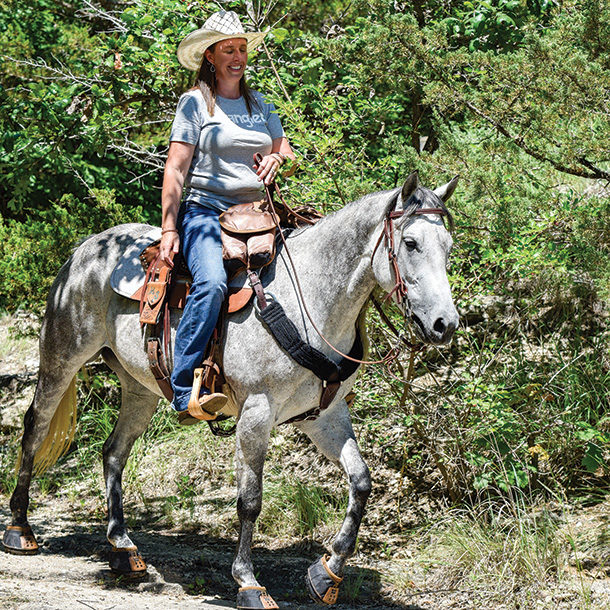Arnold Nagely, DVM, co-founder of Valley Vet Supply, explains more about equine osteoarthritis (OA), also referred to as equine degenerative joint disease (DJD).
“This is a common condition horses experience that results in degeneration of joint cartilage and pain, inflammation, reduced flexibility and range of motion. Any joint is at risk for developing arthritis over time, whether the hips, hocks, stifles or knees and fetlocks. While it’s certainly common, it’s important to know that it is manageable, should your ranch horse one day be impacted. And, luckily, there are also many ways to help prevent it.”
What causes arthritis in horses?
Trauma to the joint, a horse’s conformation defects, their age, improper shoeing and trimming, as well as sequential bone fragments can all cause equine arthritis.
What are the signs of arthritis in horses?
There are a number of signs that your horse could be affected, including:
- Limping or lameness in single or multiple joints
- Warm-to-the-touch, swollen or painful joints
- Reluctance or difficulty standing, walking, trotting or cantering
- Stiffness or decreased movement of joints
At what age do horses get arthritis?
OA can impact every horse, no matter their age, breed or discipline. It’s a common misconception that the condition impacts only senior horses, however. Horse owners will need to take preventive steps early on to control their horse’s risk and manage with prompt diagnosis and proactive treatment, should their horse develop OA over time.
How do you prevent arthritis in horses?
By getting ahead of what problems could arise because of a horse’s conformation or housing/training environments, you can help prevent joint issues.
- Incorporate horse joint supplements to support healthy joints and improved mobility.
- Prioritize hoof care and keep horses on a regular trim schedule.
- Keep horses at their optimum weight, as obesity stresses joints.
- Ensure they receive excellent nutrition to encourage strong bones and healthy cartilage.
- Limit riding on hard surfaces, if possible, and instead opt for softer footing.
What is the most common cause of lameness in horses?
It is estimated that OA is responsible for up to 60% of all lameness in horses. Although any horse in any discipline can be affected by OA, there are common themes and joint problems that occur in varying equine sports. Such as for cutting and reining horses who have greater impact on their hocks and stifles, causing them to have heightened OA risk to these joints. Any joint that is more significantly used on a horse increases its likelihood for developing OA.
How can I tell if my horse is in pain?
“Horses almost never say ‘No.’ Horses can talk, and it is our job to learn how to speak their language and above all, to listen and be their advocate,” says Steve Allday, DVM, an equine lameness specialist with more than 35 years’ experience caring for an impressive list of equine athletes.
To help address underrecognized signs of pain in horses, co-authoring Drs. Catherine Torcivia and Sue McDonnell, from the University of Pennsylvania School of Veterinary Medicine, published “Equine Discomfort Ethogram.” The report outlines 73 equine discomfort behaviors and grouped them into eight categories: posture and weight-bearing; limb and body movements; head, neck, mouth and lip movements; attention to area; ear and tail movements; overall demeanor; altered eating or drinking; and vocalizations/audible sounds. You can find their published work online to review detailed illustrations, written descriptions and even videos to best know whether your horse is in pain.
If you suspect your horse is suffering from joint pain, request an examination from your veterinarian.
How do I know if my horse has arthritis?
Owners and riders are excellent diagnosticians of any changes in a horse’s joint health. “This is simply because you know your horse. When I go look at a horse, I’m taking a snapshot of just that moment, while you have known the horse for days and years – sometimes, his entire life – before I got there that day,” says Allday, who recommends giving horses a close once-over when grooming or tacking up for a ride.
Look to see if one side is larger than the other. Also, rub the horse’s back and palpate it to make sure it isn’t sore, and always check their hocks for any fluid. Share any new findings with your veterinarian.
Should your veterinarian suspect joint problems, it’s likely they will perform a routine lameness evaluation. In addition to observing your horse during a routine lameness examination, your veterinarian has several diagnostic tools available for determining whether your horse has arthritis, including radiographs, fluoroscopy, nuclear scintigraphy, CT, MRI, nerve and joint blocks, ultrasound and thermography.
How can you tell if your horse is lame?
Allday recommends you lunge or hand trot your horse and look for a “nod.” If their head goes down when the right front leg goes forward, the problem is in the left front. If they “toe-heel” on their hind legs, it’s a sure sign there is pain in the heel, frog or other form of lower-limb lameness.
Can arthritis in horses become worse over time?
“Osteoarthritis is ubiquitous in all mammals and progressive as a rule,” says Allday. With proactive treatment and joint health supplements to prevent the condition from worsening, arthritis in horses can be manageable.
Can you ride a horse with arthritis?
The short answer is “Yes,” but it depends. Talk with your veterinarian about your horse’s level of arthritis to know whether with treatment, he or she recommends the horse being ridden. “OA isn’t the end of their career, but it’s certainly something you have to be on top of, address rapidly and maintain routinely,” says Allday. “You may even have to go to anti-inflammatories to maintain a horse’s athletic career.”
What is the best treatment for equine arthritis?
“While there is, unfortunately, no definitive cure for OA in horses, the pain and inflammation associated with equine osteoarthritis can be treated. Veterinarians may recommend prescription medications to manage the pain and inflammation associated with osteoarthritis. We continue to hear firsthand accounts of success from horsemen,” says Nagely.
Should OA be diagnosed, your veterinarian will work closely with you on joint health needs to prevent further progression of joint damage, as well as inform you of anti-inflammatory treatments available to alleviate the pain and inflammation associated with osteoarthritis.
Rein in equine arthritis risk through proactive prevention measures, and speak with your veterinarian should your horse show signs of developing arthritis. We only get so many minutes in the saddle with our horse; let’s help make the most of every single one of them.









